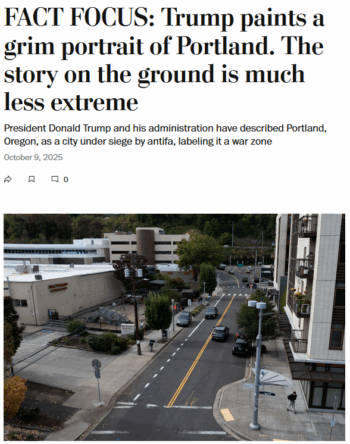“When young directors come to me, I tell them: Read, read, read, read, read. If you don’t read, you’ll presumably make films anyway, but they’ll be mediocre at best. If you don’t read, you’ll never make anything great.
If your opinion of a work art changes after you find out which tools were used to make it, or who the artist is or what they’ve done, you’re no longer judging the art. You’re making a choice not to form your opinion based on the work itself, but rather on something else. […] If an image, a song, a poem, or video evokes affection in your heart, and then that affection dissipates when you learn what tools were used to create it, that’s not a test of the work of art itself. To me it’s no different than losing affection for a movie only upon learning that special effects were created digitally, not practically.
Gruber is a tech writer, not an art critic, but his view is not uncommon, and I think it’s nonsense. Knowing how Chuck Close’s paintings were made changes the experience of them, and should.

Or consider this 16h-century Dutch miniature altarpiece — something I make a beeline for whenever I’m in the British Museum:

If I found out that it had been 3D-printed rather than meticulously hand-carved, that would change my experience of it, and rightly so.
In precisely the same way, I judge an essay differently — I apply different standards, have different reactions — depending on whether (a) it was written by a 20-year-old student who is wrestling with the things we’ve been discussing in class or (b) it was written by ChatGPT at that student’s prompt.
See also: “Pierre Menard, Author of the Quixote.”
Gruber appears to be interested only in artistic product, not artistic process. I’m interested in both, as are most people, and our judgments of works of art are complex things that involve everything we know about both process and product.
When you strip away the excuses, what you see in those messages isn’t immaturity — it’s indoctrination. It’s a group of self-described “patriots” using memes and shock jokes to normalize fascism and racism. And when a sitting U.S. Vice President like JD Vance rushes to dismiss it all as “boys being boys,” he’s not just minimizing it — he’s endorsing it. He’s saying, “We’ll look the other way, as long as you’re on our team.”One person on the chat, Michael Bartels, works in the White House. And he still has his job.
Let’s be clear: these “boys” are not boys. The Young Republicans’ age range is 18 to 40. These are adults — grown men and women with jobs, influence, and in many cases, aspirations for public office. They can vote, serve, lead, and shape the culture of a political party that already has a dangerous authoritarian streak. So when their private conversations are filled with “I love Hitler” posts and racist filth, it’s not just youthful stupidity—it’s a window into the moral vacuum that the GOP has cultivated. These are the foot soldiers of a movement that worships power and cruelty, not character or compassion.

New York Times (10/10/25): “The repercussions of those dueling versions of reality became clear.”
As more and more US cities face the prospect of federal police and military patrolling their streets, the New York Times (10/10/25) began a recent article on the fight over sending National Guard troops to Portland, Oregon, with the following passage:
Democratic leaders in the city and state have pleaded with President Trump and the courts to trust law enforcement records, both local and federal, that describe the demonstrations as small and comparatively calm.
But in the bifurcated media world of 2025, one side’s comparative calm is the other’s “hellscape.”
By “both-sidesing” its description of the protests in Portland, the Times fails to inform its readers that one of these descriptions is true and the other is simply fabricated. Instead, it tells readers the situation reflects “dueling versions of reality.”
Compare this to Michael Tomasky’s reporting in the New Republic (10/13/25), which aptly notes in the kicker that “the disturbances in Portland are basically limited to a single block about two miles from the city center.”
Or the snarky factcheck website Is Portland Burning? which shows images of the serene city and video of a calm, small protest.
Elsewhere, the Times (10/11/25) has written about the funny animal costumes worn by protesters in Portland, reporting that could have been used to debunk MAGA claims that the city is a “hellscape.”
‘Both officials disagree’

Taking a “closer look” at Trump’s claim that “in Portland, Oregon, antifa thugs have repeatedly attacked our offices and laid siege to federal property in an attempt to violently stop the execution of federal law,” AP (via Washington Post, 10/9/25) began its response, “There have been nightly protests outside the US Immigration and Customs Enforcement building in Portland for months, peaking in June when police declared one demonstration a riot.”
In an Associated Press factchecking piece (reprinted in the Washington Post, 10/9/25), promising to take “a closer look at the facts” about Portland, only one of Trump’s claims (that in Portland, “you don’t even have sewers anymore”) is met with a forthright “this is false.” Other times, the AP struggles to find a kernel of truth in the Trump administration’s bizarre claims:
TRUMP: “The amazing thing is, you look at Portland and you see fires all over the place. You see fights, and I mean just violence. It’s just so crazy. And then you talk to the governor and she acts like everything is totally normal, there’s nothing wrong.”
THE FACTS: Fires outside the building have been seen on a handful of occasions.
Or, like the Times, it resorts to both-sidesing it:
KRISTI NOEM, Homeland Security Secretary: “I was in Portland yesterday and had the chance to visit with the governor of Oregon, and also the mayor there in town, and they are absolutely covering up the terrorism that is hitting their streets.”
THE FACTS: Noem did visit Portland on Tuesday and met with Kotek and Mayor Keith Wilson. Both officials disagree with Noem’s narrative.
These failings by the media leave the reader or viewer at the mercy of what are posed as competing narratives, rather than with an understanding of what’s real and what’s fake. This is particularly important now, given that right-wing influencers and media are ginning up false claims for the administration to consume and rebroadcast, and even instigating real incidents (Oregon Public Broadcasting, 10/11/25).
When corporate media refuse to call a lie a lie, and to stand unequivocally on the side of reality, they enable the Trump administration’s growing authoritarianism. If Trump can claim that a major US city is “burning to the ground,” what’s to stop him from asserting that the Constitution allows him to run for a third term—or that, once again, he’s won an election that he actually lost?
Featured Image: Detail from New York Times photo (10/11/25) of Portland protests (photo: Jordan Gale).
